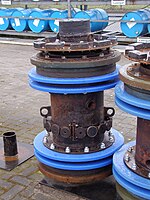
Photo from wikipedia
Abstract In this paper, an ensemble learning framework combining the sparse autoencoder (SAE) network with an improved support vector machine (SVM) is established to enhance the accuracy of classification in… Click to show full abstract
Abstract In this paper, an ensemble learning framework combining the sparse autoencoder (SAE) network with an improved support vector machine (SVM) is established to enhance the accuracy of classification in detecting the pipeline leakage. First of all, the SAE network is introduced to extract the discriminative and robust features of the pipeline leakage data. Then, a kind of leader–follower particle swarm optimization (LFPSO) algorithm is put forward to optimize the parameters of the SVM algorithm such that the probability trapping into the local optimum is effectively reduced. Next, the proposed LFPSO-SVM approach is employed to further classify and recognize the features extracted from the pipeline leakage data via the SAE network. Moreover, the performance of the SAE-LFPSO-SVM approach is quantitatively evaluated by three performance indicators, i.e., sensitivity, positive predictive value and total classification accuracy. Finally, some simulation examples are given to demonstrate the effectiveness of the proposed SAE-LFPSO-SVM approach, which exhibits a higher classification accuracy than that of the other traditional classification algorithms.
Journal Title: Neurocomputing
Year Published: 2020
Link to full text (if available)
Share on Social Media: Sign Up to like & get
recommendations!